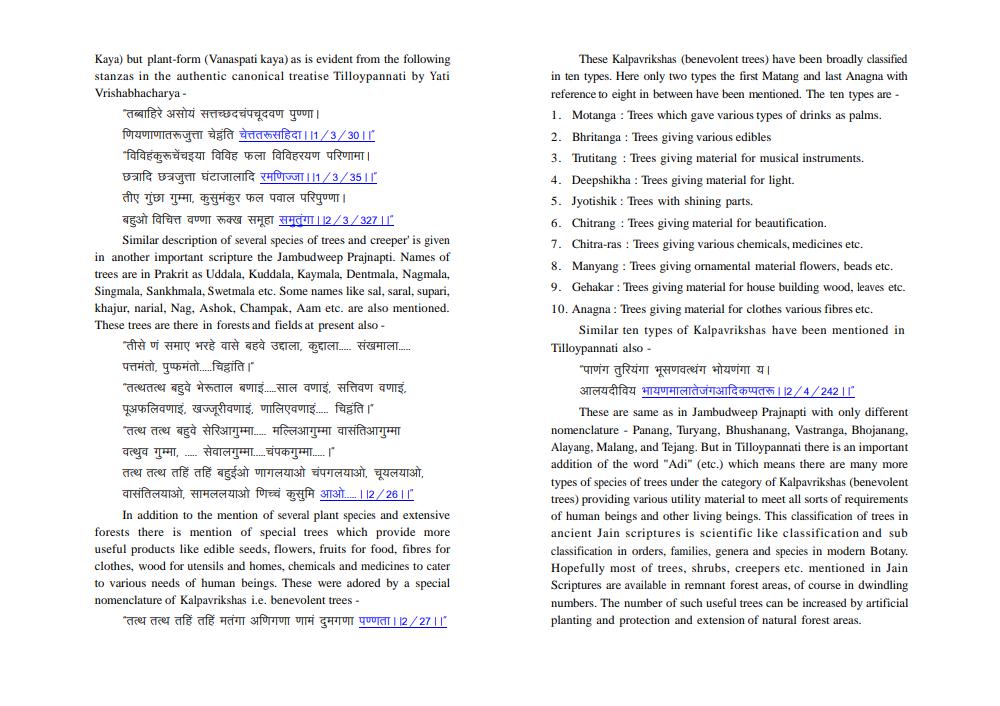________________
Kaya) but plant-form (Vanaspati kaya) as is evident from the following stanzas in the authentic canonical treatise Tilloypannati by Yati Vrishabhacharya -
तब्बाहिरे असोयं सत्तच्छदचंपचूदवण पुण्णा। णियणाणातरूजुत्ता चेहँति चेत्ततरूसहिदा।।1/3/30\r 'विविहंकुरूचेचइया विविह फला विविहरयण परिणामा। छत्रादि छत्रजुत्ता घंटाजालादि रमणिज्जा111/3/351r तीए गुंछा गुम्मा, कुसुमंकुर फल पवाल परिपुण्णा।। बहुओ विचित्त वण्णा रूक्ख समूहा समतुंगा। 12/3/327 ||"
Similar description of several species of trees and creeper' is given in another important scripture the Jambudweep Prajnapti. Names of trees are in Prakrit as Uddala, Kuddala, Kaymala, Dentmala, Nagmala, Singmala, Sankhmala, Swetmala etc. Some names like sal, saral, supari, khajur, narial, Nag, Ashok, Champak, Aam etc. are also mentioned. These trees are there in forests and fields at present also -
'तीसे णं समाए भरहे वासे बहवे उद्दाला, कुद्दाला..... संखमाला.... पत्तमंतो, पुष्फमतो....चिट्ठांति।" "तत्थतत्थ बहुवे भेरूताल बणाई...साल वणाई, सत्तिवण वणाइं. पूअफलिवणाई, खज्जूरीवणाई, णालिएवणाई..... चिट्ठति।' 'तत्थ तत्थ बहुवे सेरिआगुम्मा..... मल्लिआगुम्मा वासंतिआगुम्मा वत्थुव गुम्मा, ..... सेवालगुम्मा.....चंपकगुम्मा....." तत्थ तत्थ तहिं तहिं बहुईओ णागलयाओ चंपगलयाओ, चूयलयाओ, वासंतिलयाओ, सामललयाओ णिच्चं कुसुमि आओ.... ||2/26 |"
In addition to the mention of several plant species and extensive forests there is mention of special trees which provide more useful products like edible seeds, flowers, fruits for food, fibres for clothes, wood for utensils and homes, chemicals and medicines to cater to various needs of human beings. These were adored by a special nomenclature of Kalpavrikshas i.e. benevolent trees
'तत्थ तत्थ तहिं तहिं मतंगा अणिगणा णामं दुमगणा पण्णता। 12/27 ||
These Kalpavrikshas (benevolent trees) have been broadly classified in ten types. Here only two types the first Matang and last Anagna with reference to eight in between have been mentioned. The ten types are 1. Motanga : Trees which gave various types of drinks as palms. 2. Bhritanga : Trees giving various edibles 3. Trutitang : Trees giving material for musical instruments. 4. Deepshikha : Trees giving material for light. 5. Jyotishik: Trees with shining parts. 6. Chitrang : Trees giving material for beautification. 7. Chitra-ras : Trees giving various chemicals, medicines etc. 8. Manyang : Trees giving omamental material flowers, heads etc. 9. Gehakar : Trees giving material for house building wood, leaves etc. 10. Anagna : Trees giving material for clothes various fibres etc.
Similar ten types of Kalpavrikshas have been mentioned in Tilloypannati also
"पाणंग तुरियंगा भूसणवत्थंग भोयणंगा य। आलयदीविय भायणमालातेजंगआदिकप्पतरू। 12/4/242 ||
These are same as in Jambudweep Prajnapti with only different nomenclature - Panang, Turyang, Bhushanang, Vastranga, Bhojanang, Alayang, Malang, and Tejang. But in Tilloypannati there is an important addition of the word "Adi" (etc.) which means there are many more types of species of trees under the category of Kalpavrikshas (benevolent trees) providing various utility material to meet all sorts of requirements of human beings and other living beings. This classification of trees in ancient Jain scriptures is scientific like classification and sub classification in orders, families, genera and species in modem Botany. Hopefully most of trees, shrubs, creepers etc. mentioned in Jain Scriptures are available in remnant forest areas, of course in dwindling numbers. The number of such useful trees can be increased by artificial planting and protection and extension of natural forest areas.




